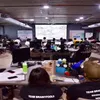Undergraduate students win Smart India Hackathon 2019 for developing tech using AR and VR
Team STAC 1 from Ajeenkya DY Patil University, Pune, bagged Rs 1 lakh cash prize at Smart India Hackathon for its innovation under the theme ‘Robotics and Drone’.
At the recently held grand finale of the Smart India Hackathon-2019 hardware edition, team STAC 1 from Ajeenkya DY Patil University, Pune, bagged Rs 1 lakh cash prize for its innovation under the theme ‘Robotics and Drone’.
Apart from STAC 1, Suvana from Muzaffarpur Institute of Technology, Muzaffarpur; and Quebik from Viva Institute of Technology, Maharashtra, and FORBOTS from Mar Baselios Institute of Technology and Science also received Rs 1 lakh each for their innovation.
They were among the 16 teams competing for the hackathon held at REVA University, Bengaluru, which was one of the 19 nodal centres in for the final round.

Team STAC 1 from Ajeenkya DY Patil University
Team STAC 1 paired a virtual reality (VR) headset with illuminating thumb controllers, using computational fluid dynamics (CFD) analysis. According to the team, this will allow a company or service provider to visually show clients the company’s plans and outcomes in 3D.
It received largely positive reactions when the team, led by Pranshu Tople (20), demonstrated it at Ingersoll Rand at IBC Knowledge Park, recently. They are now working with the company and hoping to launch the product by September this year.
“The device can visually show a client how their end product will look like. For example, if an office wants to install AC, this device can be used to show how they are planning to build it and where the ACs will be installed before the work has begun,” Pallavi Saha, a team member, told YourStory.
She also explained that it can be applied in almost every field from something as complex as designing products like car and building architecture plans to simple recreational plans.
Other members of the team include Yatish Kumavat (20), Shubham Nandi (20), G Santosh (19), and Tanay Mitkari (21), all undergraduate students pursuing Mechatronics at Ajeenkya DY Patil University.
Their innovation is built on the understanding that clients have little idea of what might be delivered to them as most people do not understand the technical workings. As companies have a hard time walking them through the process, projects often end up in reworks and customer dissatisfaction, costing time and labour for both. STAC 1’s innovation will translate the complex analysis or plans and visually present it in 3D.
Soon, the team hopes to use other software like SolidWorks and AutoCAD, which will be more efficient, especially in architecture. According to the members, the ultimate aim is to set a benchmark for enhanced user experience.
Tracing steps in AR and VR
Student Technical Activity Club (STAC) was initially set up during the team's first year in college. Since then, the club has hosted multiple programmes, encouraging other students to take part in various robotics competitions and hackathons held across the country.
However, they explored augmented reality (AR) and virtual reality (VR) for the first time during their college fest ‘Hashtech’. For this, the students experimented with VR games such as killing zombies, which became a huge success at the university.
The team believes VR and AR are the next milestones in visualisations and interpretations. According to them, when the hardware edition of Smart India Hackathon (SIH) was announced, it felt like the right opportunity to explore more of the field, while also bridging gaps in the industry with their customer-centric product.
As undergraduate students, developing this technology was not an easy feat for them. A first of its kind, very few people had harnessed these tools before. But the team left no stone unturned, and approached YouTuber Matthew Hallberg, who runs a tutorial channel on topics like Apple ARkit, ARcore, machine learning (ML), and AR/VR, among others. The team also used various open-source material available to develop the tech.
Apart from AR and VR, the technology is built using image processing, i2c serial communication, and multiple programming languages to give it an edge.

The road ahead
Claiming that the system can benefit any organisation, industry, or service provider, the team hopes to become a household name in the industry when it comes to product planning and visualisation.
Speaking on their participation in the event, they said,
“It was a wonderful opportunity for us to present the work and be recognised by industry experts as well as the Government of India. Moreover, spending time with other participants coming up with innovative ideas, which if given the right platform can transform the world, has been absolutely fantastic.”
Expressing gratitude to the organisers, the group of young students said it will be a pleasure if they can give back to society and the country in any way.
(Edited by Megha Reddy)










